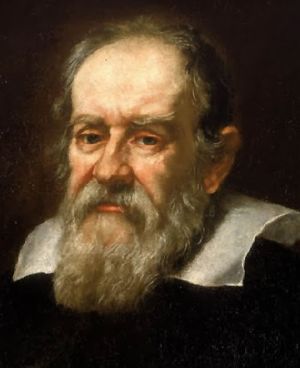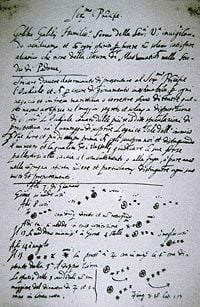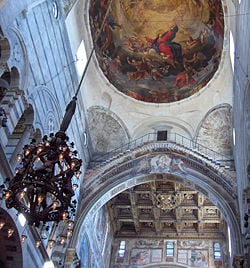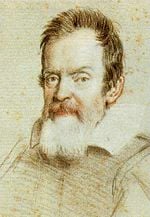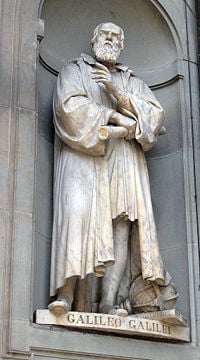Galileo Galilei
- "Galileo" redirects here.
Galileo Galilei (Pisa, February 15 1564 – Arcetri, January 8 1642), was an Italian physicist, astronomer, and philosopher who is closely associated with the scientific revolution. His achievements include improvements to the telescope, a variety of astronomical observations, the first law of motion, the second law of motion, and effective support for Copernicanism. He has been referred to as the "father of modern astronomy", as the "father of modern physics", and as "father of science". His experimental work is widely considered complementary to the writings of Francis Bacon in establishing the modern scientific method. Galileo's career coincided with that of Johannes Kepler. The work of Galileo is considered to be a significant break from that of Aristotle. In addition, his conflict with the Roman Catholic Church is taken as a major early example of the conflict of authority and freedom of thought, particularly with science, in Western society.
Family and early career
Galileo was born in Pisa, in the Tuscan region of Italy, the son of Vincenzo Galilei, a mathematician and musician born in Florence in 1520, and Giulia Ammannati, born in Pescia and married in 1563. Galileo was their first child. Although a devout Catholic, Galileo fathered three children out of wedlock. All were the children of Galileo and Marina Gamba. Because of their illegitimate birth, both girls were sent to the convent of San Matteo in Arcetri at early ages.
- Virginia (1600–1634) who took the name Maria Celeste upon entering a convent. Galileo's eldest child, the most beloved, and inherited her father's sharp mind. She died on April 2, 1634. She is buried with Galileo at the Basilica di Santa Croce di Firenze.
- Livia (b. 1601) took the name Suor Arcangela, she was sickly for most of her life at the convent.
- Vincenzio (b. 1606) was later legitimized and married Sestilia Bocchineri.
Galileo was home-schooled at a very young age. After that he attended the University of Pisa, but was forced to cease his study there for financial reasons. However, he was offered a position on its faculty in 1589 and taught mathematics. Soon after, he moved to the University of Padua, and served on its faculty teaching geometry, mechanics, and astronomy until 1610. During this time he explored science and made many landmark discoveries.
Experimental science
In the pantheon of the scientific revolution, Galileo takes a high position because of his pioneering use of quantitative experiments with results analyzed mathematically. There was no tradition of such methods in European thought at that time; the great experimentalist who immediately preceded Galileo, William Gilbert, did not use a quantitative approach. However, Galileo's father, Vincenzo Galilei, had performed experiments in which he discovered what may be the oldest known non-linear relation in physics, between the tension and the pitch of a stretched string. Galileo also contributed to the rejection of blind allegiance to authority (like the Church) or other thinkers (such as Aristotle) in matters of science and to the separation of science from philosophy or religion. These are the primary justifications for his description as the "father of science".
In the 20th century some authorities challenged the reality of Galileo's experiments, in particular the distinguished French historian of science Alexandre Koyré. The experiments reported in Two New Sciences to determine the law of acceleration of falling bodies, for instance, required accurate measurements of time, which appeared to be impossible with the technology of the 1600s. According to Koyré, the law was arrived at deductively, and the experiments were merely illustrative thought experiments.
Later research, however, has validated the experiments. The experiments on falling bodies (actually rolling balls) were replicated using the methods described by Galileo (Settle, 1961), and the precision of the results was consistent with Galileo's report. Later research into Galileo's unpublished working papers from as early as 1604 clearly showed the reality of the experiments and even indicated the particular results that led to the time-squared law (Drake, 1973).
Astronomy
Contributions
Although the popular idea of Galileo inventing the telescope is inaccurate, he was one of the first people to use the telescope to observe the sky, and for a time was one of very few people able to make a telescope good enough for the purpose. Based on sketchy descriptions of telescopes invented in the Netherlands in 1608, Galileo made one with about 8x magnification, and then made improved models up to about 20x. On August 25, 1609, he demonstrated his first telescope to Venetian lawmakers. His work on the device also made for a profitable sideline with merchants who found it useful for their shipping businesses. He published his initial telescopic astronomical observations in March 1610 in a short treatise entitled Sidereus Nuncius (Sidereal Messenger).
On January 7, 1610 Galileo discovered three of Jupiter's four largest satellites (moons): Io, Europa, and Callisto. He discovered Ganymede four nights later. He determined that these moons were orbiting the planet since they would appear and disappear; something he attributed to their movement behind Jupiter. He made additional observations of them in 1620. Later astronomers overruled Galileo's naming of these objects, changing his Medicean stars to Galilean satellites. The demonstration that a planet had smaller planets orbiting it was problematic for the orderly, comprehensive picture of the geocentric model of the universe, in which everything circled around the Earth.
Galileo noted that Venus exhibited a full set of phases like the Moon. The heliocentric model of the solar system developed by Copernicus predicted that all phases would be visible since the orbit of Venus around the Sun would cause its illuminated hemisphere to face the Earth when it was on the opposite side of the Sun and to face away from the Earth when it was on the Earth-side of the Sun. By contrast, the geocentric model of Ptolemy predicted that only crescent and new phases would be seen, since Venus was thought to remain between the Sun and Earth during its orbit around the Earth. Galileo's observation of the phases of Venus proved that Venus orbited the Sun and lent support to (but did not prove) the heliocentric model.
Galileo was one of the first Europeans to observe sunspots, although there is evidence that Chinese astronomers had done so before. He also reinterpreted a sunspot observation from the time of Charlemagne, which formerly had been attributed (impossibly) to a transit of Mercury. The very existence of sunspots showed another difficulty with the unchanging perfection of the heavens as assumed in the older philosophy. And the annual variations in their motions, first noticed by Francesco Sizzi, presented great difficulties for either the geocentric system or that of Tycho Brahe. A dispute over priority in the discovery of sunspots led to a long and bitter feud with Christoph Scheiner; in fact, there can be little doubt that both of them were beaten by David Fabricius and his son Johannes.
He was the first to report lunar mountains and craters, whose existence he deduced from the patterns of light and shadow on the Moon's surface. He even estimated the mountains' heights from these observations. This led him to the conclusion that the Moon was "rough and uneven, and just like the surface of the Earth itself", and not a perfect sphere as Aristotle had claimed.
Galileo observed the Milky Way, previously believed to be nebulous, and found it to be a multitude of stars, packed so densely that they appeared to be clouds from Earth. He also located many other stars too distant to be visible with the naked eye.
Galileo observed the planet Neptune in 1612, but did not realize that it was a planet and took no particular notice of it. It appears in his notebooks as one of many unremarkable dim stars.
Modern claims of scientific errors and misconduct
Although Galileo is generally considered one of the first modern scientists, as evidenced by his position in the sunspot controversy, he is often said to have arrogantly considered himself to be the sole proprietor of the discoveries in astronomy.
Furthermore, he never accepted Kepler's elliptical orbits for the planets, holding to the circular orbits of Copernicus, which still employed epicycles to account for irregularities in planetary motions. (The circle was considered the "perfect" shape.)
Concerning his theory on tides, Galileo attributed them to momentum despite his great knowledge of the ideas of relative motion and Kepler's better theories using the Moon as the cause. (Neither of these great scientists, however, had a workable physical theory of tides; this had to wait for the work of Newton.) Galileo stated in his Dialogue that, if the Earth spins on its axis and is traveling at a certain speed around the Sun, parts of the Earth must travel "faster" at night and "slower" during the day. This, of course, is true in the Sun's frame of reference; but it is by no means adequate to explain the tides.
Many commentators consider that Galileo developed this position simply to justify his own opinion because the theory was not based on any real scientific observations. If his theory was correct, there would be only one high tide per day and it would happen at noon. The fact that there are two daily high tides at Venice instead of one, and that they travel around the clock, Galileo and his contemporaries knew, but he dismissed as due to several secondary causes, such as the shape of the sea, its depth, and other things. Against the imputation that Galileo was guilty of some kind of deceit in making these arguments one may take the position of Albert Einstein, as one who had done original work in physics, that Galileo developed his "fascinating arguments" and accepted them too uncritically out of a desire for a physical proof of the motion of the Earth (Einstein, 1952).
Physics
Galileo's theoretical and experimental work on the motions of bodies, along with the largely independent work of Kepler and René Descartes, was a precursor of the Classical mechanics developed by Sir Isaac Newton. He was a pioneer, at least in the European tradition, in performing rigorous experiments and insisting on a mathematical description of the laws of nature.
One of the most famous stories about Galileo is that he dropped balls of different masses from the Leaning Tower of Pisa to demonstrate that their time of descent was independent of their mass (excluding the limited effect of air resistance). This was contrary to what Aristotle had taught: that heavy objects fall faster than lighter ones, in direct proportion to weight. Though the story of the tower first appeared in a biography by Galileo's pupil Vincenzo Viviani, it is not now generally accepted as true. Moreover, Giambattista Benedetti had reached the same scientific conclusion years before, in 1553. However, Galileo did perform experiments involving rolling balls down inclined planes, which proved the same thing: falling or rolling objects (rolling is a slower version of falling, as long as the distribution of mass in the objects is the same) are accelerated independently of their mass. (Although Galileo was the first person to demonstrate this via experiment, he was not (contrary to popular belief) the first to argue that it was true. John Philoponus had argued this centuries earlier).
He determined the correct mathematical law for acceleration: the total distance covered, starting from rest, is proportional to the square of the time (This law is regarded as a predecessor to the many later scientific laws expressed in mathematical form.). He also concluded that objects retain their velocity unless a force – often friction – acts upon them, refuting the accepted Aristotelian hypothesis that objects "naturally" slow down and stop unless a force acts upon them (again John Philoponus had proposed a similar (though erroneous) theory). Galileo's Principle of Inertia stated: "A body moving on a level surface will continue in the same direction at constant speed unless disturbed." This principle was incorporated into Newton's laws of motion (1st law).
Galileo also noted that a pendulum's swings always take the same amount of time, independently of the amplitude. The story goes that he came to this conclusion by watching the swings of the bronze chandelier in the cathedral of Pisa, using his pulse to time it. While Galileo believed this equality of period to be exact, it is only an approximation appropriate to small amplitudes. It is good enough to regulate a clock, however, as Galileo may have been the first to realize. (See Technology below)
In the early 1600s, Galileo and an assistant tried to measure the speed of light. They stood on different hilltops, each holding a shuttered lantern. Galileo would open his shutter, and, as soon as his assistant saw the flash, he would open his shutter. At a distance of less than a mile, Galileo could detect no delay in the round-trip time greater than when he and the assistant were only a few yards apart. While he could reach no conclusion on whether light propagated instantaneously, he recognized that the distance between the hilltops was perhaps too small for a good measurement.
Galileo is lesser known for, yet still credited with being one of the first to understand sound frequency. After scraping a chisel at different speeds, he linked the pitch of sound to the spacing of the chisel's skips (frequency).
In his 1632 Dialogue Galileo presented a physical theory to account for tides, based on the motion of the Earth. If correct, this would have been a strong argument for the reality of the Earth's motion. (The original title for the book, in fact, described it as a dialogue on the tides; the reference to tides was removed by order of the Inquisition.) His theory gave the first insight into the importance of the shapes of ocean basins in the size and timing of tides; he correctly accounted, for instance, for the negligible tides halfway along the Adriatic Sea compared to those at the ends. As a general account of the cause of tides, however, his theory was a failure. Kepler and others correctly associated the Moon with an influence over the tides, based on empirical data; a proper physical theory of the tides, however, was not available until Newton.
Galileo also put forward the basic principle of relativity, that the laws of physics are the same in any system that is moving at a constant speed in a straight line, regardless of its particular speed or direction. Hence, there is no absolute motion or absolute rest. This principle provided the basic framework for Newton's laws of motion and is the infinite speed of light approximation to Einstein's special theory of relativity.
Mathematics
While Galileo's application of mathematics to experimental physics was innovative, his mathematical methods were the standard ones of the day. The analyses and proofs relied heavily on the Eudoxian theory of proportion, as set forth in the fifth book of Euclid's Elements. This theory had become available only a century before, thanks to accurate translations by Tartaglia and others; but by the end of Galileo's life it was being superseded by the algebraic methods of Descartes, which a modern finds incomparably easier to follow.
Galileo produced one piece of original and even prophetic work in mathematics: Galileo's paradox, which shows that there are as many perfect squares as there are whole numbers, even though most numbers are not perfect squares. Such seeming contradictions were brought under control 250 years later in the work of Georg Cantor.
Technology
Galileo made a few contributions to what we now call technology as distinct from pure physics, and suggested others. This is not the same distinction as made by Aristotle, who would have considered all Galileo's physics as techne or useful knowledge, as opposed to episteme, or philosophical investigation into the causes of things.
In 1595–1598, Galileo devised and improved a "Geometric and Military Compass" suitable for use by gunners and surveyors. This expanded on earlier instruments designed by Niccolo Tartaglia and Guidobaldo del Monte. For gunners, it offered, in addition to a new and safer way of elevating cannons accurately, a way of quickly computing the charge of gunpowder for cannonballs of different sizes and materials. As a geometric instrument, it enabled the construction of any regular polygon, computation of the area of any polygon or circular sector, and a variety of other calculations.
About 1606–1607 (or possibly earlier), Galileo made a thermometer, using the expansion and contraction of air in a bulb to move water in an attached tube.
In 1609, Galileo was among the first to use a refracting telescope as an instrument to observe stars, planets or moons.
In 1610, he used a telescope as a compound microscope, and he made improved microscopes in 1623 and after. This appears to be the first clearly documented use of the compound microscope.
In 1612, having determined the orbital periods of Jupiter's satellites, Galileo proposed that with sufficiently accurate knowledge of their orbits one could use their positions as a universal clock, and this would make possible the determination of longitude. He worked on this problem from time to time during the remainder of his life; but the practical problems were severe. The method was first successfully applied by Giovanni Domenico Cassini in 1681 and was later used extensively for land surveys; for navigation, the first practical method was the chronometer of John Harrison.
In his last year, when totally blind, he designed an escapement mechanism for a pendulum clock. The first fully operational pendulum clock was made by Christiaan Huygens in the 1650s.
He created sketches of various inventions, such as a candle and mirror combination to reflect light throughout a building, an automatic tomato picker, a pocket comb that doubled as an eating utensil, and what appears to be a ballpoint pen.
Church controversy
- Main article: Galileo affair.
Psalms 93 and 104, and Ecclesiastes 1:5 speak of the motion of celestial bodies and the suspended position of the earth. Galileo defended heliocentrism, and claimed it was not contrary to those Scripture passages. He took Augustine's position on Scripture: not to take every passage too literally. This particularly applies when it is a book of poetry and songs, not a book of instructions or history. The writers of the Scripture wrote from the perspective of the terrestrial world, and from that vantage point the sun does rise and set. In fact, it is the earth's rotation which gives the impression of the sun in motion across the sky.
By 1616 the attacks on Galileo had reached a head, and he went to Rome to try to persuade the Church authorities not to ban his ideas. In the end, Cardinal Bellarmine, acting on directives from the Inquisition [1], delivered him an order not to "hold or defend" the idea that the Earth moves and the Sun stands still at the center. The decree did not prevent Galileo from hypothesizing heliocentrism. For the next several years Galileo stayed well away from the controversy.
He revived his project of writing a book on the subject, encouraged by the election of Cardinal Barberini as Pope Urban VIII in 1623. Barberini was a friend and admirer of Galileo, and had opposed the condemnation of Galileo in 1616. The book, Dialogue Concerning the Two Chief World Systems, was published in 1632, with formal authorization from the Inquisition and papal permission.
Pope Urban VIII personally asked Galileo to give arguments for and against heliocentrism in the book, and to be careful not to advocate heliocentrism. He made another request, that his own views on the matter be included in Galileo's book. Only the latter of those requests was fulfilled by Galileo. Whether unknowingly or deliberate, Simplicius, the defender of the Aristotelian Geocentric view in Dialogue Concerning the Two Chief World Systems, was often caught in his own errors and sometimes came across as a fool. This fact made Dialogue Concerning the Two Chief World Systems appear as an advocacy book; an attack on Aristotelian geocentrism and defense of the Copernican theory. To add insult to injury, Galileo put the words of Pope Urban VIII into the mouth of Simplicius. Most historians agree Galileo did not act out of malice and felt blindsided by the reaction to his book. However, the pope did not take the public ridicule lightly, nor the blatant bias. Galileo had alienated one of his biggest and most powerful supporters, the pope, and was called to Rome to explain himself.
With the loss of many of his defenders in Rome because of Dialogue Concerning the Two Chief World Systems, Galileo was ordered to stand trial on suspicion of heresy in 1633. The sentence of the Inquisition was in three essential parts:
- Galileo was required to recant his heliocentric ideas, which were condemned as "formally heretical";.
- He was ordered imprisoned; the sentence was later commuted to house arrest.
- His offending Dialogue was banned; and in an action not announced at the trial, publication of any of his works was forbidden, including any he might write in the future.
After a period with the friendly Ascanio Piccolomini (the Archbishop of Siena), Galileo was allowed to return to his villa at Arcetri near Florence, where he spent the remainder of his life under house arrest. It was while Galileo was under house arrest when he dedicated his time to one of his finest works, Two New Sciences. This book has received high praise from both Sir Isaac Newton and Albert Einstein. As a result of this work, Galileo is often called, the "father of modern physics".
On 31 October 1992, Pope John Paul II officially announced that the Church had mishandled the case.
Galileo's writings
- Two New Sciences 1638 Lowys Elzevir (Louis Elsevier) Leiden (in Italian, Discorsi e Dimostrazioni Matematiche, intorno á due nuoue scienze Leida, Appresso gli Elsevirii 1638)
- Letters on Sunspots
- The Assayer (In Italian, Il Saggiatore)
- Dialogue Concerning the Two Chief World Systems 1632 (in Italian, Dialogo dei due massimi sistemi del mondo)
- The Starry Messenger 1610 Venice (in Latin, Sidereus Nuncius)
- Letter to Grand Duchess Christina
Writings on Galileo
- Galileo Galilei, an opera by Philip Glass
- Galileo a play by Bertolt Brecht
- Lamp at Midnight a play by Barrie Stavis
- Galileo's Daughter, a Memoir by Dava Sobel
ReferencesISBN links support NWE through referral fees
- Drake, Stillman (1953). Dialogue Concerning the Two Chief World Systems. Berkeley: University of California Press.
- Drake, Stillman (1957). Discoveries and Opinions of Galileo. New York: Doubleday & Company. ISBN 0-385-09239-3
- Drake, Stillman (1973). "Galileo's Discovery of the Law of Free Fall". Scientific American v. 228, #5, pp. 84-92.
- Drake, Stillman (1978). Galileo At Work. Chicago: University of Chicago Press. ISBN 0-226-16226-5
- Einstein, Albert (1952). Foreword to (Drake, 1953)
- Fantoli, Annibale (2003). Galileo — For Copernicanism and the Church, third English edition. Vatican Observatory Publications. ISBN 88-209-7427-4
- Fillmore, Charles (1931, 17th printing July 2004). Metaphysical Bible Dictionary. Unity Village, Missouri: Unity House. ISBN 0-871-59067-0
- Hellman, Hal (1988). Great Feuds in Science. Ten of the Liveliest Disputes Ever. New York: Wiley.
- Lessl, Thomas, "The Galileo Legend". New Oxford Review, 27-33 (June 2000).
- Newall, Paula (2004). "The Galileo Affair."
- Settle, Thomas B. (1961). "An Experiment in the History of Science". Science, 133:19-23.
- Sobel, Dava. (1999). Galileo's Daughter. ISBN 0-140-28055-3
- White, Andrew Dickson (1898). A History of the Warfare of Science with Theology in Christendom. New York 1898.
Named after Galileo
- The Galileo mission to Jupiter
- The Galilean moons of Jupiter
- Galileo Regio on Ganymede
- Galilaei crater on the Moon
- Galilaei crater on Mars
- Asteroid 697 Galilea (named on the occasion of the 300th anniversary of the discovery of the Galilean moons)
- Galileo (unit of acceleration)
- Galileo positioning system
- Galileo stadium in Miami, Florida
See also
- Eppur si muove
- Galilean transformation
- Galilean invariance
- List of people on stamps of Ireland
- Lorentz transformation equations
- Medici
- Renaissance
- Vincenzo Galilei
External links
- Biography of Galileo Galilei with links to related objects conserved in the Institute and Museum of the History of Science in Florence, Italy
- Galileo theme-based virtual visit to the Institute and Museum of the History of Science in Florence, Italy including videos
- Galileo's "Notes on Motion" - online digital edition with transcriptions
- Galileo's compass an educational interactive application to explore online the history and uses of Galileo's compass
- Galileo//Thek@ - an online digital archive of Galilean resources (including bibliographies, biographies, digital books, itineraries, manuscripts, experiments, documents, iconography, and more
- Galileo Affair catholic.net
- The Galileo Affair by Paula Newall.
- The Warfare of Science With Theology
- The Galileo Project at Rice University
- CCD Images through a Galilean Telescope Modern recreation of what Galileo might have seen; includes directions for using Galileo//Thek@ website
- about Galileo Galilei at danask.com
- Electronic representation of Galilei's notes on motion (MS. 72)
- From Myth to History and Back — Reviews of two books on Galileo
- PBS Nova Online: Galileo's Battle for the Heavens
- Stanford Encyclopedia of Philosophy entry
- The Galilean Library, an educational site dedicated to Galileo
- Galileo's writings in Italian language, an Italian site dedicated to free e-texts
- Galileo Galilei, in the Catholic Encyclopedia found online on New Advent, an orthodox Catholic website
- John J. O'Connor and Edmund F. Robertson. Galileo Galilei at the MacTutor archive
Credits
New World Encyclopedia writers and editors rewrote and completed the Wikipedia article in accordance with New World Encyclopedia standards. This article abides by terms of the Creative Commons CC-by-sa 3.0 License (CC-by-sa), which may be used and disseminated with proper attribution. Credit is due under the terms of this license that can reference both the New World Encyclopedia contributors and the selfless volunteer contributors of the Wikimedia Foundation. To cite this article click here for a list of acceptable citing formats.The history of earlier contributions by wikipedians is accessible to researchers here:
The history of this article since it was imported to New World Encyclopedia:
Note: Some restrictions may apply to use of individual images which are separately licensed.
